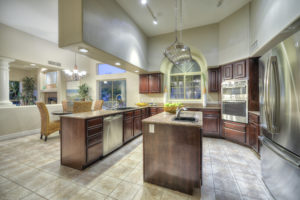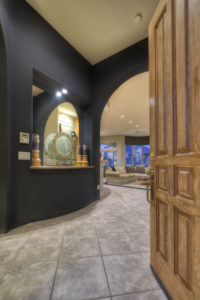1. Find a bookcase
Choose a bookcase with at least three wide shelves so you can store gear in a variety of sizes.
2. Add locking wheels
Attach locking wheels to the bottom of the bookcase so you can easily move it around the mudroom or the garage.
3. Drill holes
Drill evenly spaced holes (about four or five, depending on the width of the bookcase) along the top surface of one of the shelves. You’ll want the holes to be fairly close to the edge — about one-half inch away or less. On the underside of the shelf below, drill holes to match up exactly with the holes on the shelf above.
4. Attach bungee cords
Place the bungee cord hooks in the drilled holes, and arrange the cords vertically so they create a net. You want the cords to be pretty taut, so be sure to get the right size for your bookcase.
5. Mount peg boards
Frame the sides of your bookcase with 1x2s to support peg boards that have been cut to size. Secure the peg boards with a few nails on the top and bottom.
6. Customize with hooks and holders
Place hooks and holders on the peg board so you can hang your tennis rackets, baseball gloves, jerseys, helmets, and more.
7. Load up your catchall, MVP!
Grab your gear and organize the bins like you’re Russell Westbrook going for another triple-double. Now all you have to worry about is scoring the winning goal. Please note that this Scottsdale Real Estate Blog is for informational purposes and not intended to take the place of a licensed Scottsdale Real Estate Agent. The Szabo Group offers first class real estate services to clients in the Scottsdale Greater Phoenix Metropolitan Area in the buying and selling of Luxury homes in Arizona. Award winning Realtors and Re/MAX top producers and best real estate agent for Luxury Homes in Scottsdale, The Szabo group delivers experience, knowledge, dedication and proven results. Contact Joe Szabo at 480.688.2020, [email protected] or visit www.scottsdalerealestateteam.com to find out more about Scottsdale Homes for Sale and Estates for Sale in Scottsdale and to search the Scottsdale MLS for Scottsdale Home Listings.
Please note that this Scottsdale Real Estate Blog is for informational purposes and not intended to take the place of a licensed Scottsdale Real Estate Agent. The Szabo Group offers first class real estate services to clients in the Scottsdale Greater Phoenix Metropolitan Area in the buying and selling of Luxury homes in Arizona. Award winning Realtors and Re/MAX top producers and best real estate agent for Luxury Homes in Scottsdale, The Szabo group delivers experience, knowledge, dedication and proven results. Contact Joe Szabo at 480.688.2020, [email protected] or visit www.scottsdalerealestateteam.com to find out more about Scottsdale Homes for Sale and Estates for Sale in Scottsdale and to search the Scottsdale MLS for Scottsdale Home Listings.
 Although many people are flipping houses these days, Lindberg and Cederlind take a unique approach: a design-first attitude using reclaimed pieces found anywhere, from Craigslist to salvage yards to the side of the road.
“I think what people really want is character — they want a house that’s unusual,” Cederlind says. “A new tract house in Mississippi looks like a new tract house in Minnesota. People want to add character back in.”
Lindberg adds, “I think a lot of builders are good at construction, but they’re not design people. That’s where we feel we’re different — we’re design people first.”
A creative approach to both flipping and using reclaimed materials involves seeing potential others might overlook — and being willing to undertake a transformation. “Twice now we’ve bought an old, beautiful table with big, curvy gorgeous legs,” recalls Lindberg. “We cut it in half, and then we made double vanities. It makes a pedestal sink, so the two legs are out in the room, and the cut part is against the wall.”
Although many people are flipping houses these days, Lindberg and Cederlind take a unique approach: a design-first attitude using reclaimed pieces found anywhere, from Craigslist to salvage yards to the side of the road.
“I think what people really want is character — they want a house that’s unusual,” Cederlind says. “A new tract house in Mississippi looks like a new tract house in Minnesota. People want to add character back in.”
Lindberg adds, “I think a lot of builders are good at construction, but they’re not design people. That’s where we feel we’re different — we’re design people first.”
A creative approach to both flipping and using reclaimed materials involves seeing potential others might overlook — and being willing to undertake a transformation. “Twice now we’ve bought an old, beautiful table with big, curvy gorgeous legs,” recalls Lindberg. “We cut it in half, and then we made double vanities. It makes a pedestal sink, so the two legs are out in the room, and the cut part is against the wall.”





 By
By 


